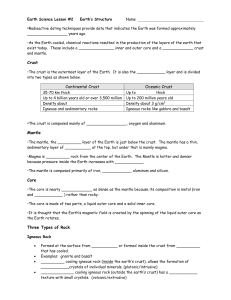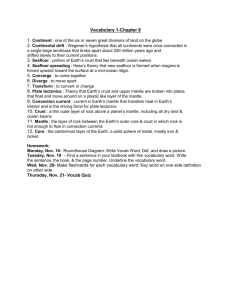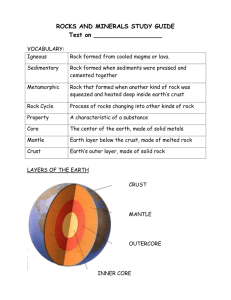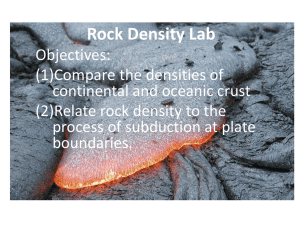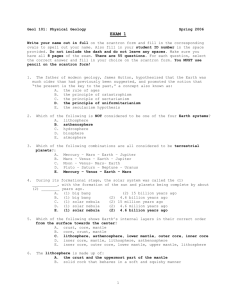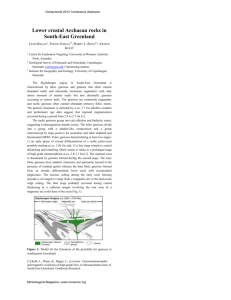A. Types of Rocks
advertisement
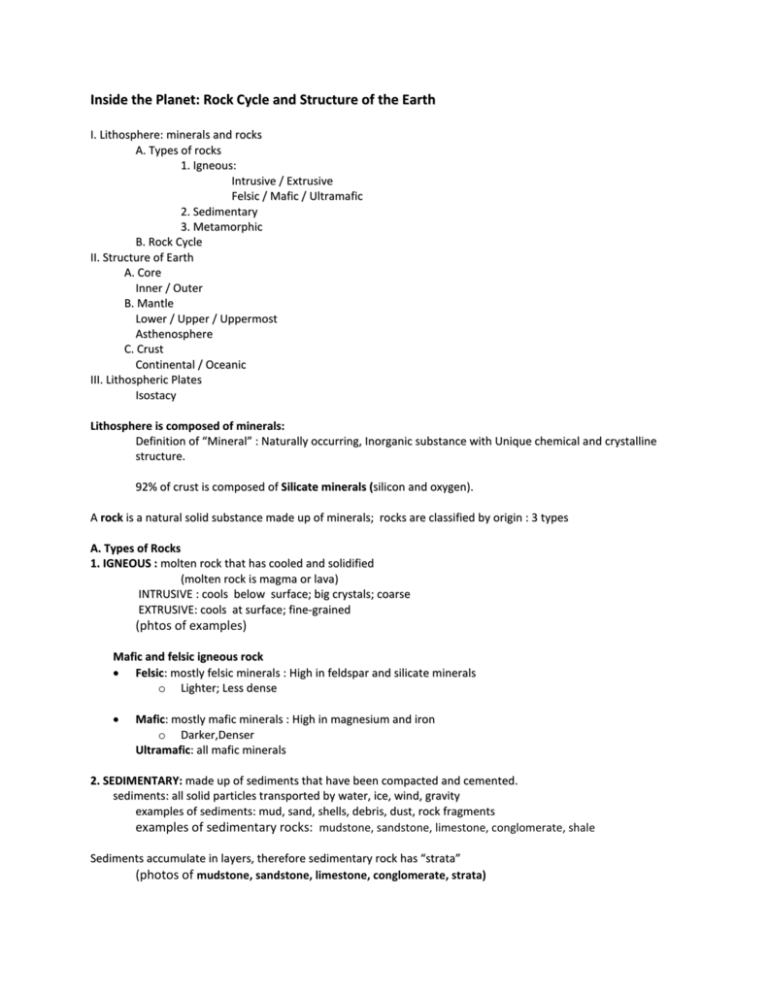
Inside the Planet: Rock Cycle and Structure of the Earth I. Lithosphere: minerals and rocks A. Types of rocks 1. Igneous: Intrusive / Extrusive Felsic / Mafic / Ultramafic 2. Sedimentary 3. Metamorphic B. Rock Cycle II. Structure of Earth A. Core Inner / Outer B. Mantle Lower / Upper / Uppermost Asthenosphere C. Crust Continental / Oceanic III. Lithospheric Plates Isostacy Lithosphere is composed of minerals: Definition of “Mineral” : Naturally occurring, Inorganic substance with Unique chemical and crystalline structure. 92% of crust is composed of Silicate minerals (silicon and oxygen). A rock is a natural solid substance made up of minerals; rocks are classified by origin : 3 types A. Types of Rocks 1. IGNEOUS : molten rock that has cooled and solidified (molten rock is magma or lava) INTRUSIVE : cools below surface; big crystals; coarse EXTRUSIVE: cools at surface; fine-grained (phtos of examples) Mafic and felsic igneous rock Felsic: mostly felsic minerals : High in feldspar and silicate minerals o Lighter; Less dense Mafic: mostly mafic minerals : High in magnesium and iron o Darker,Denser Ultramafic: all mafic minerals 2. SEDIMENTARY: made up of sediments that have been compacted and cemented. sediments: all solid particles transported by water, ice, wind, gravity examples of sediments: mud, sand, shells, debris, dust, rock fragments examples of sedimentary rocks: mudstone, sandstone, limestone, conglomerate, shale Sediments accumulate in layers, therefore sedimentary rock has “strata” (photos of mudstone, sandstone, limestone, conglomerate, strata) 3. METAMORPHIC: altered from original rock by heat, pressure or chemical activity; began as igneous, sedimentary, or metamorphic rock shale --> slate slate --> schist granite --> gneiss limestone --> marble (Photos of gneiss, schist, slate) Rock Cycle (diagram and explanation of processes) II. Structure of Earth : composed of layers: Core, Mantle, Crust A. Core Inner 5150 – 6370 km (below surface) Solid iron 5400 – 9000 degrees F Outer 2900 – 5150 km Molten iron B. Mantle Lower mantle very dense; iron and magnesium 670 – 2900 km Upper mantle rigid at lower end 250 – 670 km “plastic” toward crust: asthenosphere 70 - 250 Uppermost mantle Rigid “Moho” to 70 km Mohorovičić discontinuity Boundary between crust and mantle Change in seismic waves here C. Crust continental : 25 miles thick Lower mafic; upper felsic (granite) Less dense oceanic: 5-6 miles thick Mafic (basalt) More dense Lithosphere = uppermost mantle and crust (rigid; ultramafic) III. Lithospheric Plates Lithosphere is divided into large plates. Rigid plates “float” on the plastic asthenosphere, just deep enough to support their own weight: Isostacy Isostatic adjustment of crust: add weight (sediment, glacial ice): crust will sink remove weight (erosion, glacial ice melts): crust will rebound



